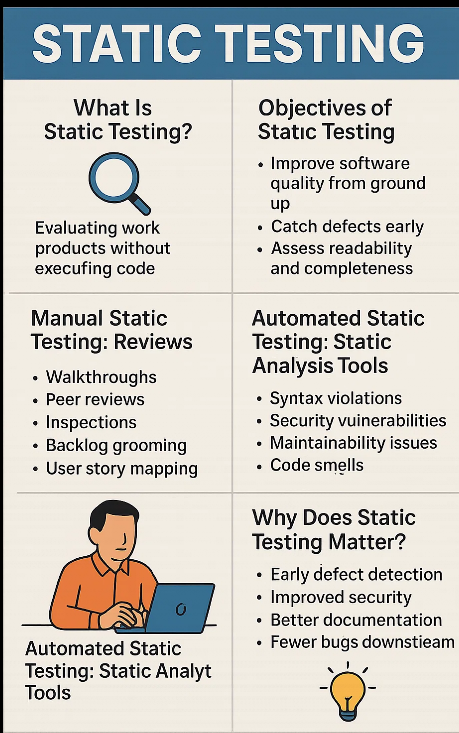Static Testing Basics
When we think about software testing, most minds jump to running test cases, clicking buttons, or automating flows. But there’s a powerful side of testing that works silently, without even executing a single line of code.
Welcome to the world of Static Testing — an underrated yet vital technique in building high-quality software.

🔍 What Is Static Testing?
Static testing is the process of evaluating work products without executing the code. It’s the art of detecting defects early by examining documents, architecture, and code through reviews or static analysis tools.
In contrast to dynamic testing (which involves running software), static testing focuses on verification and preventive defect detection.
🎯 Objectives of Static Testing
The goals of static testing go beyond finding bugs. It helps to:
- Improve software quality from the ground up
- Catch defects early in the development cycle
- Assess readability, completeness, testability, and consistency
- Verify that artifacts meet predefined criteria (like Definition of Ready)
This makes static testing an indispensable activity, especially in agile and DevOps workflows.
✋ Manual Static Testing: Reviews
Static testing includes human-led activities like:
- Walkthroughs
- Peer Reviews
- Inspections
- Backlog Grooming
- User Story Mapping
In Agile environments, testers work collaboratively with developers and product owners during example mapping, story writing, and refinement sessions to ensure clarity and quality before code is even written.
Testers ask critical questions:
- Are acceptance criteria clear?
- Is the story testable?
- Does this story align with the business goal?
This early involvement ensures fewer defects and less rework later.
🛠️ Automated Static Testing: Static Analysis Tools
Static analysis tools automatically analyze code, models, or structured documents without execution. They help uncover:
- Syntax violations
- Security vulnerabilities
- Maintainability issues
- Code smells or complexity
- Style inconsistencies
Examples of Static Analysis Tools:
- SonarQube — Code quality, maintainability, and security
- ESLint — JavaScript linting
- FindBugs / SpotBugs — Java bug detection
- Spell checkers / Readability tools — For documentation quality
These tools are often integrated into Continuous Integration (CI) pipelines for automated checks during code commits or builds — ensuring quality is baked into the process.
📄 What Can Be Reviewed in Static Testing?
Static testing isn’t limited to code. It applies to almost any work product:
- ✅ Requirements & Specifications
- ✅ Source code
- ✅ Test plans, test cases
- ✅ Backlog items & user stories
- ✅ Contracts & compliance documents
- ✅ Architecture & models
If it can be read and understood, it can be reviewed.
However, static analysis (automated) requires structured input — like code, structured models, or syntax-compliant text.
❌ Note: Static testing is not suitable for 3rd-party compiled binaries or any files protected by legal or IP constraints.
💡 Why Does Static Testing Matter?
Here’s why teams that leverage static testing thrive:
- 📉 Early defect detection → saves time and cost
- 🔒 Improved security → by catching vulnerabilities in code
- 📚 Better documentation & clarity → before implementation begins
- 🔁 Fewer bugs downstream → because misunderstandings are resolved early
📌 Final Thoughts
Static testing is like brushing your teeth: it’s not flashy, but skip it and you’ll soon feel the pain. It complements dynamic testing by preventing defects instead of just detecting them.
In today’s fast-moving Agile and DevOps landscapes, integrating static testing into your workflow means:
- Higher confidence
- Cleaner code
- Fewer regressions
- Faster releases
So don’t wait for bugs to appear. Start catching them before they happen — with the silent superpower of static testing.
👍 Found this helpful?
Clap 👏, follow 🧑💻, and share 📢 with your fellow developers and testers!